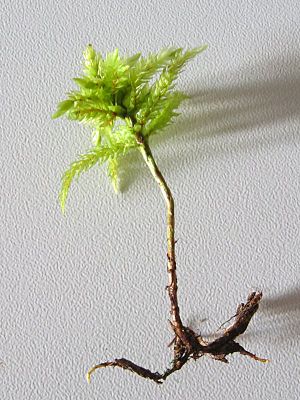Tree climacium moss facts for kids
Quick facts for kids Tree climacium moss |
|
|---|---|
 |
|
| Scientific classification | |
| Genus: |
Climacium
|
| Species: |
dendroides
|
Climacium dendroides, also called tree climacium moss, is a special type of moss. It gets its name "tree moss" because it looks like tiny trees. The word "dendroides" means "tree-like." This moss was first described by scientists Weber and Mohr in 1804.
This moss often grows in patches, looking like small palm trees. Its stems can be 2 to 10 centimeters tall. The tips of its branches are usually yellow-green. Its leaves are tiny, about 2.5 to 3 millimeters long. Some leaves are rounder, while others are pointier. You can often see its special reproductive parts, called sporophytes, in late winter and early spring. These look like red-brown shoots with long stalks and cylinder-shaped capsules.
Contents
Where Tree Moss Lives
This moss loves places that are wet and damp. You can find it in swamps, bogs, and near the edges of lakes. It also grows well in forests with lots of rich soil. It likes areas where the water level changes often.
Tree climacium moss can grow on the ground or on wood and logs. It rarely grows on rocks or in very dry places. You can find it from sea level up to high mountain areas. This moss is found in many places but is not super common. It lives in northern and central Europe and Asia. You can also find it in the South Island of New Zealand. In North America, it grows in the northeastern parts and as far south as New Mexico. It is also found in countries like Japan and Korea.
What Tree Moss Looks Like
This moss can be dark green to yellow. It might even look shiny when it is dry. It has two types of leaves: stem leaves and branch leaves. These leaves look a bit different.
The stem leaves are flatter against the stem and wider. They have round tips and are not folded. The branch leaves are narrower and have tiny teeth near their tips. They also have folds that run lengthwise. Both types of leaves are shaped like an egg, but branch leaves are thinner. The leaves are about 2.5 to 3 millimeters long.
The way the leaves are arranged makes the plant look like a small palm tree. The upright stems are about 2 to 3 centimeters tall. They grow from horizontal stems that look like roots. The upright stems are reddish-brown. They look more like trees in places with lots of moisture. The tree-like part, which is 2 to 10 centimeters tall, grows from these branched horizontal stems.
The moss also has capsules, which are upright and cylinder-shaped. They are about 1.5 to 4 millimeters long. These capsules are not seen very often. This is because male plants are rarer than female plants.
Life Cycle of Tree Moss
Most plants, like trees, have two sets of chromosomes. But mosses, called bryophytes, have only one set of chromosomes for part of their life. This happens during the sporophyte stage.
The life cycle begins with a tiny spore. This spore has only one set of chromosomes. When it lands in a good spot, it grows into a thread-like structure called a protonema. The protonema then grows buds. These buds turn into the leafy moss plant you see, called a gametophore.
The gametophore is the main moss plant. It has stems and leaves. This plant also has only one set of chromosomes. The gametophore makes special parts that hold the sperm and eggs. Climacium dendroides has male and female parts on different plants.
The female part is called the archegonia. It is shaped like a small flask. It has a neck where the sperm swim down to reach the egg. The male part is called the antheridia.
When there is water, like rain, the sperm swim from the male antheridia to the female archegonia. The sperm then fertilizes the egg. This creates a new plant part called a sporophyte. The sporophyte now has two sets of chromosomes.
The young sporophyte grows out of the female archegonia. It has a stalk, called a seta, that holds up a capsule. This capsule has a cap on top. Inside the capsule, tiny spores are made. These spores have only one set of chromosomes. When the sporophyte is ready, the cap falls off. The spores are then released, often carried by the wind. When a spore lands in a new place, the life cycle starts all over again.
Reproduction
You usually see the sporophytes, which are the reproductive parts, in late winter and early spring. This is when there is a lot of moisture. The short, cylinder-shaped capsules of this moss usually become mature in the fall.
As mentioned, this moss has separate male and female plants. The spores are released when the capsule cap opens. This release can be helped by changes in moisture. The capsule also has tiny teeth that help control when the spores come out. Each spore is a single cell.
Tree Moss in Culture
In 2017, the Latvian Botanists' Association named Climacium dendroides their "Moss of the Year."
Mosses That Look Similar
- Leucolepis acanthoneuron also looks like a tiny tree. However, it does not grow from a creeping stem like Climacium. Its stem leaves are whitish and narrow, while Climacium has green, heart-shaped stem leaves. Also, Leucolepis often has its sporophytes in spring, and they nod downwards. Climacium has upright sporophytes.

